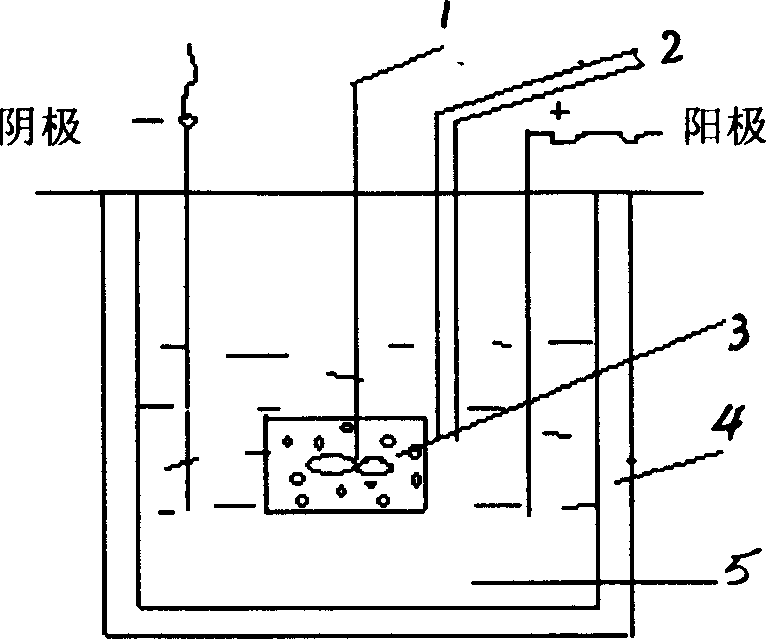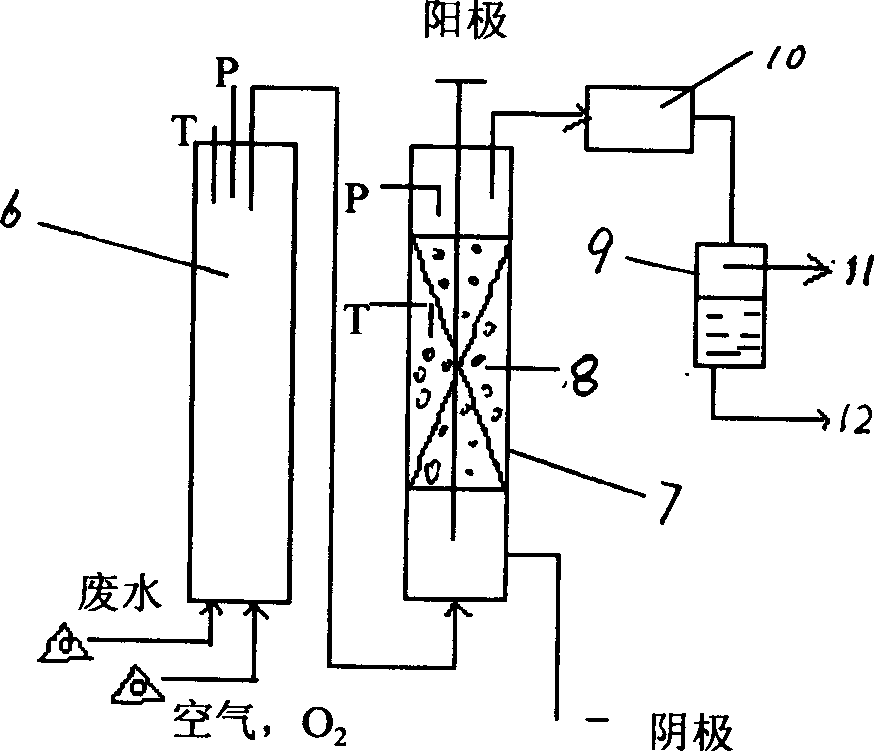Method and apparatus for treating high concentrated organic wastewater by hydrothermal electrical catalytic oxidation
A technology of organic wastewater and catalytic oxidation, applied in the direction of oxidized water/sewage treatment, water/sewage treatment, chemical instruments and methods, etc., can solve problems such as high operating costs, long time, salt blockage, etc., to reduce costs and operating costs , the effect of improving efficiency
- Summary
- Abstract
- Description
- Claims
- Application Information
AI Technical Summary
Problems solved by technology
Method used
Image
Examples
Embodiment 1
[0021] Embodiment 1: Implementation on the intermittent device:
[0022] 1. Using a batch reactor:
[0023] Reactor 316L stainless steel body 500ml (equipment of prior art);
[0024] Anode: Titanium mesh plated PbO 2 , 2×7mm (or plated with lead dioxide, or antimony trioxide, or tin oxide, or ruthenium oxide or their mixture);
[0025] Catalyst: a catalyst composed of 75% titanium oxide, 20% cerium oxide, 0.5% ruthenium, and 4.5% bismuth oxide (or other existing catalysts);
[0026] Cathode: the reactor itself;
[0027] Voltage: 6V; Current: 5A;
[0028] Electrolyte Na 2 SO 4 5% (accounting for 5% of the wastewater volume);
[0029] COD concentration (initial) 18000ppm 150ml waste water (phenol);
[0030] NH 3 -N concentration (initial) 3000ppm
[0031] o 2 Partial pressure 1MPa (initial) PH adjustment to 10
[0032] Temperature 200°C Reaction time 1 hour
[0033] COD removal rate 90% NH 3 -N 99%
Embodiment 2
[0034] Example 2: Implementation on a continuous device
[0035] The electrolytic reactor is a cylindrical flow device, that is, sewage and oxygen-containing gas enter from the bottom of the reactor, and the treated sewage is continuously discharged after heat exchange and gas-liquid separation, so that sewage treatment can be carried out automatically and continuously.
[0036] in:
[0037] Anode: conductive carbon coated with a layer of tin oxide;
[0038] Catalyst: Ru / Ce-ZrO 2 ;
[0039] Voltage: 6V; Current: 5A;
[0040] Reactor volume 2L, NH 3 N concentration (initial) 3000ppm COD initial concentration 18000ppm (phenol and ammonium sulfate);
[0041] Cathode: the reactor itself;
[0042] The processing results are shown in the table below:
[0043] T 100°C 150°C 180°C 200°C 250°C
[0044] T 100°C 150°C 180°C 200°C
Embodiment 3
[0045] Example 3: Implementation on a continuous device:
[0046]The electrolytic reactor is a cylindrical flow device, that is, sewage and oxygen-containing gas enter from the bottom of the reactor, and the treated sewage is continuously discharged after heat exchange and gas-liquid separation, so that sewage treatment can be carried out automatically and continuously.
[0047] in:
[0048] Anode: Ruthenium oxide is first coated on the titanium rod, and then a layer of lead oxide is coated;
[0049] Cathode: titanium mesh;
[0050] Solid filling material: granular activated carbon (or granular diatomite, or shaped molecular sieve, or titanium oxide, or aluminum oxide, or zirconium oxide, or cordierite, or water-insoluble inorganic materials such as magnesium oxide);
[0051] Voltage: 6V, PO 2 Divided pressure is 2MPa; Current: 10A;
[0052] Wastewater is coking wastewater, COD is 19950PPm, NH 3 -N is 1300PPm;
[0053] Adjust pH ≈ 11, add 5% Na of wastewater 2 SO 4 as ...
PUM
 Login to View More
Login to View More Abstract
Description
Claims
Application Information
 Login to View More
Login to View More - R&D
- Intellectual Property
- Life Sciences
- Materials
- Tech Scout
- Unparalleled Data Quality
- Higher Quality Content
- 60% Fewer Hallucinations
Browse by: Latest US Patents, China's latest patents, Technical Efficacy Thesaurus, Application Domain, Technology Topic, Popular Technical Reports.
© 2025 PatSnap. All rights reserved.Legal|Privacy policy|Modern Slavery Act Transparency Statement|Sitemap|About US| Contact US: help@patsnap.com


